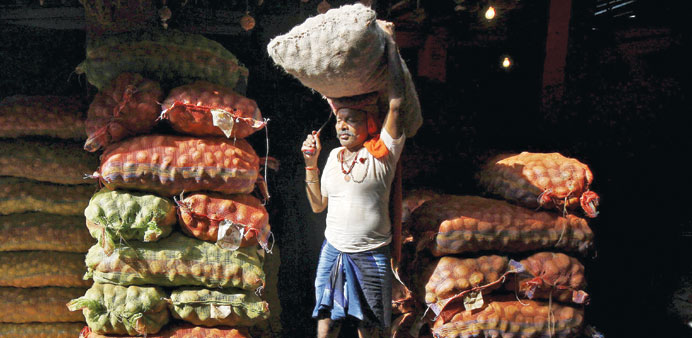A labourer carries a sack of onions at a vegetable market in Kolkata. India’s retail inflation likely cooled in July as food price rise stayed in check.
Bloomberg/New Delhi
India’s inflation eased more than estimated, adding pressure on central bank governor Raghuram Rajan to cut interest rates after China devalued its currency.
Consumer prices rose 3.78% in July from a year earlier after a 5.40% increase in June, the statistics ministry said in a statement in New Delhi yesterday. The median of 39 estimates in a Bloomberg survey of economists had predicted a 4.4% gain.
Rajan kept rates unchanged this month to contain Asia’s third-fastest inflation even as the government has pressured him to lower one of the region’s highest borrowing costs.
Immediately after the latest inflation figure was released, a finance ministry official reiterated to reporters that Rajan must cut rates sharply.
“Chances of a rate cut have increased after this data,” said Prasanna Ananthasubramanian, chief economist at ICICI Securities Primary Dealership in Mumbai. He predicts Rajan will lower the rate one more time in the fiscal year through March, though not before the next scheduled review on September 29.
Industrial production grew 3.8% in June, the statistics ministry said in a separate statement. That was more than a median forecast of 3.5% in a Bloomberg survey.
The Reserve Bank of India forecasts inflation will ease to 4% in August before rising towards its target of 6% by January. The projection hasn’t fully accounted for the 50% plunge in global oil prices over the past year, Rajan said on August 4. He left the repurchase rate at 7.25% after cutting it three times this year.
The rupee gained in the offshore market after the data, with the one-month non-deliverable forward rising to 65.08 per dollar from 65.18. The onshore markets had shut before the release.Most economists in another Bloomberg survey predict Rajan will maintain policy through this year with the US poised to tighten. Swaps are pricing in the possibility of a cut to 7%.
Standard Chartered and Barclays say Rajan’s inflation focus, falling oil prices and a possible increase in US interest rates this year will prevent him from depreciating the rupee aggressively after China devalued its yuan.
Food inflation is another risk. India’s monsoon rainfall was 9% below average since June 1. The Food Price Index rose 2.15% in July from a year earlier after a 5.48% increase in June.“Significant uncertainty will be resolved in the coming months, including the likely persistence of recent inflationary pressures, the full monsoon out-turn, as well as possible Federal Reserve actions,” Rajan said on August 4 when he held interest rates.



